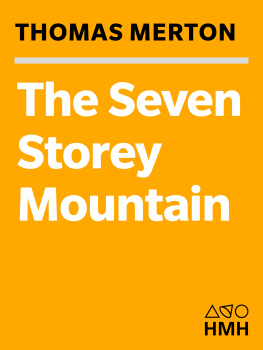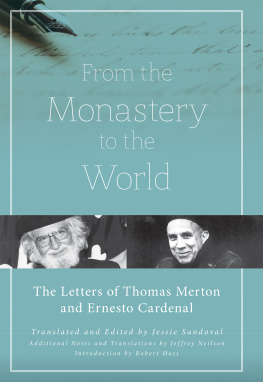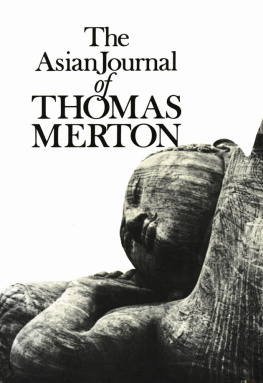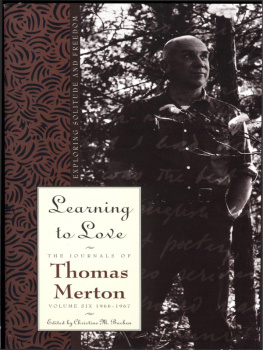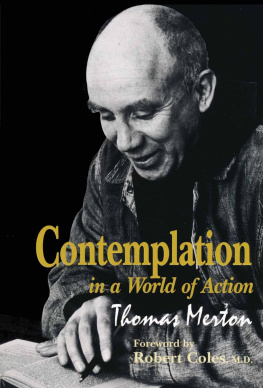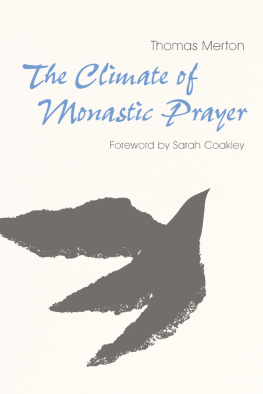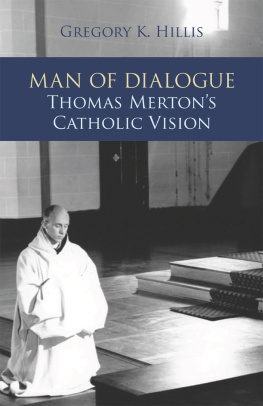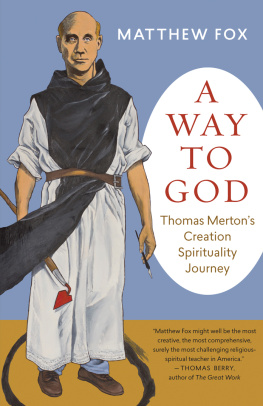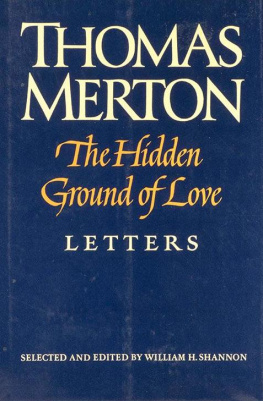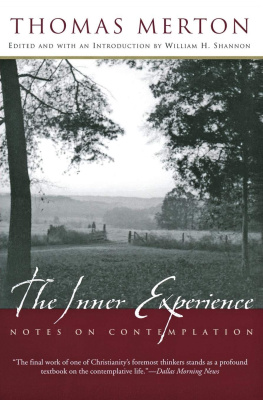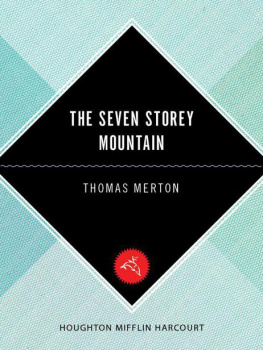Thomas Merton - The Seven Storey Mountain: Fiftieth-Anniversary Edition
Here you can read online Thomas Merton - The Seven Storey Mountain: Fiftieth-Anniversary Edition full text of the book (entire story) in english for free. Download pdf and epub, get meaning, cover and reviews about this ebook. year: 1998, publisher: Harcourt Brace, genre: Art. Description of the work, (preface) as well as reviews are available. Best literature library LitArk.com created for fans of good reading and offers a wide selection of genres:
Romance novel
Science fiction
Adventure
Detective
Science
History
Home and family
Prose
Art
Politics
Computer
Non-fiction
Religion
Business
Children
Humor
Choose a favorite category and find really read worthwhile books. Enjoy immersion in the world of imagination, feel the emotions of the characters or learn something new for yourself, make an fascinating discovery.
- Book:The Seven Storey Mountain: Fiftieth-Anniversary Edition
- Author:
- Publisher:Harcourt Brace
- Genre:
- Year:1998
- Rating:5 / 5
- Favourites:Add to favourites
- Your mark:
- 100
- 1
- 2
- 3
- 4
- 5
The Seven Storey Mountain: Fiftieth-Anniversary Edition: summary, description and annotation
We offer to read an annotation, description, summary or preface (depends on what the author of the book "The Seven Storey Mountain: Fiftieth-Anniversary Edition" wrote himself). If you haven't found the necessary information about the book — write in the comments, we will try to find it.
The Seven Storey Mountain: Fiftieth-Anniversary Edition — read online for free the complete book (whole text) full work
Below is the text of the book, divided by pages. System saving the place of the last page read, allows you to conveniently read the book "The Seven Storey Mountain: Fiftieth-Anniversary Edition" online for free, without having to search again every time where you left off. Put a bookmark, and you can go to the page where you finished reading at any time.
Font size:
Interval:
Bookmark:
For I tell you that God is able of these stones
to raise up children to Abraham
Introduction copyright 1998 by Robert Giroux
Note to the Reader copyright 1998 by William H. Shannon
Copyright 1948 by Harcourt, Inc.
Copyright renewed 1976 by the Trustees of the Merton Legacy Trust
All rights reserved. No part of this publication may be reproduced or transmitted in any form or by any means, electronic or mechanical,including photocopy, recording, or any information storage and retrieval system, without permission in writing from the publisher.
For information about permission to reproduce selections from this book, write to Permissions, Houghton Mifflin Harcourt Publishing Company, 215 Park Avenue South, New York, New York 10003.
www.hmhco.com
The poem Song for Our Lady of Cobre on by Thomas Merton, from The Collected Poems of Thomas Merton. Copyright 1944 by Our Lady of Gethsemani Monastery. Reprinted by permission of New Directions Publishing Corp.
The poem For My Brother: Reported Missing in Action, 1943 on , by Thomas Merton, from The Collected Poems ofThomas Merton. Copyright 1948 by New Directions Publishing Corporation, 1997 by The Trustees of the Merton Legacy Trust. Reprinted by permission of New Directions Publishing Corp.
Ex parte Ordinis:
Nihil obstat: F R . M. G ABRIEL. O C ONNELL , O.C.S.O.
F R . M. A NTHONY C HASSAGNE , O.C.S.O.
Imprimi potest: F R . M. F REDERIC D UNNE , O.C.S.O., Abbot of Our Lady of Gethsemani
Nihil obstat: J OHN M. A. F EARNS , S.T.D., Censor librorum
Imprimatur: F RANCIS C ARDINAL S PELLMAN , Archbishop of New York
ISBN -13: 978-0-15-100413-3
ISBN -10: 0-15-100413-7
ISBN -13: 978-0-15-601086-3 (pbk)
ISBN -10: 0-15-601086-0 (pbk)
e ISBN 978-0-547-54381-9
v3.1114
CHRISTO
VERO
REGI
by Robert Giroux
The Seven Storey Mountain was first published fifty years ago, on October 4, 1948. As Thomas Merton revealed in his journals, he had begun to write his autobiography four years earlier, at the Trappist monastery in Kentucky where he had journeyed in December 1941, at age twenty-six, after resigning as a teacher of English literature at St. Bonaventure College in Olean, New York. In a certain sense, Merton wrote, one man was more responsible for The Seven Storey Mountain than I was, even as he was the cause of all my other writing. This was Dom Frederic Dunne, the abbot who had received Merton as a postulant and accepted him, in March 1942, as a Trappist novice.
I brought all the instincts of a writer with me into the monastery, Merton revealed, adding that the abbot encouraged me when I wanted to write poems and reflections and other things that came into my head in the novitiate. When Dom Frederic suggested that Merton write the story of his life, the novice was at first reluctant to do so. After all, he had become a monk in order to leave his past life behind. Once he began to write, however, it poured out. I dont know what audience I might have been thinking of, he admitted. I suppose I put down what was in me, under the eyes of God, who knows what is in me. He was soon trying to tone down his original draft for the Trappist censors, who had criticized it severely, especially the account of his years at Clare College (Cambridge University), during which he had become the father of an illegitimate child (killed with the mother apparently in the bombing of London). For this Merton was sent downexpelledfrom college, and his English guardian advised him (both his parents were dead) to leave England. He also told Merton to forget about his hopes of a London career in the diplomatic service, so Merton sailed for America and enrolled at Columbia College, where I met him in 1935.
The United States was still in the Depression; the times were serious and so were most undergraduates. Among Mertons and my classmates were Ad Reinhardt, who became a famous painter; John Latouche, who became famous in the musical theater; Herman Wouk, who became a famous novelist; John Berryman, who became a famous poet; Robert Lax, Edward Rice, Robert Gibney, and Sy Freedgood, close friends who were associated with Merton on the college humor magazine, Jester; and Robert Gerdy, who became an editor at the New Yorker.
We met on the campus when Merton walked into the office of the Columbia Review, the college literary magazine, and showed me some manuscripts, a story, and several reviews, which I liked and accepted. I thought to myself, This man is a writer. He was stocky, blue-eyed, with thinning blond hair, and he was a lively talker, with a slight British accent. He was a junior and I was a senior. He told me of his interest in jazz, Harlem, and the moviesespecially W. C. Fields, Chaplin, Keaton, the Marx Brothers, and Preston Sturges, enthusiasms I shared. We were also enthusiastic about Mark Van Doren as a teacher. We went to a couple of movies at the old Thalia, and of course in those leftist days words like religion, monasticism, and theology never came up. I graduated in June 1936, failing to get a job in book publishing (as I had hoped) and finding one at CBS. Then in December 1939 Frank V. Morley, head of the Trade Department of Harcourt Brace & Company, hired me as a junior editor, with the approval of Donald C. Brace (who had cofounded this distinguished firm in 1919 with Alfred Harcourt). Among the first manuscripts I was asked to evaluate was a novel by Thomas James Merton, submitted by Naomi Burton of the Curtis Brown Ltd. literary agency. The hero of The Straits of Dover was a Cambridge student who transfers to Columbia and gets involved with a stupid millionaire, a showgirl, a Hindu mystic, and a left-winger; it all took place in Greenwich Village. I agreed with the other editors that the writer had talent but the story wobbled around and got nowhere. Six months later Naomi resubmitted it as The Labyrinth, an improved replay of the same novel, which was also rejected. Vlerton was an interesting writer but apparently not a novelist.
For the first time after college, I encountered him in Scribners bookstore on Fifth Avenue; this was in May or June 1941. I had been browsing and felt someone touch my arm. It was Merton. Tom! I said, its great to see you. I hope youre still writing. He said, Well, Ive just been to the New Yorker and they want me to write about Gethsemani. I had no idea what he meant and said so. Oh, its a Trappist monastery in Kentucky, where Ive made a retreat. This revelation stunned me. I had had no idea that Merton had undergone a religious conversion or that he was interested in monasticism. Well, I hope to read what you write about it, I said. It will be something different for the New Yorker. Oh, no, he said, I would never think of writing about it. That told me a great deal. For the first time I understood the extraordinary change that had occurred in Merton. I wished him well and we parted.
I next heard about him from Mark Van Doren, when I called our old teacher at New Years. Tom Merton has become a Trappist monk, Mark said. Well probably never hear from him again. Hes leaving the world. An extraordinary young man. I always expected him to become a writer. Tom had left with Mark his manuscript, Thirty Poems, and Mark later submitted it to my friend Jay Laughlin at New Directions, who published it in 1944. Little did we know how many other books would follow.
The partially approved text of The Seven Storey Mountain reached Naomi Burton late in 1946. Her reaction, as Tom noted in his journal, was good: She is quite sure it will find a publisher. Anyway my ideaand hers alsois to turn it over to Robert Giroux at Harcourt Brace. This entry was dated December 13. Fourteen days later he wrote in his journal: Yesterday at dinner Father Prior handed me a telegram.... The first thought that came into my mind was that the manuscript of
Next pageFont size:
Interval:
Bookmark:
Similar books «The Seven Storey Mountain: Fiftieth-Anniversary Edition»
Look at similar books to The Seven Storey Mountain: Fiftieth-Anniversary Edition. We have selected literature similar in name and meaning in the hope of providing readers with more options to find new, interesting, not yet read works.
Discussion, reviews of the book The Seven Storey Mountain: Fiftieth-Anniversary Edition and just readers' own opinions. Leave your comments, write what you think about the work, its meaning or the main characters. Specify what exactly you liked and what you didn't like, and why you think so.

